From the 19th century to the end of the Second World War
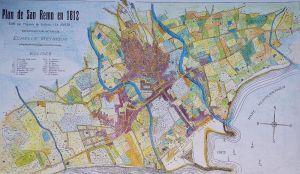 In 1802 San Remo had more than 14,000 inhabitants and in 1804 it became the seat of a subprefecture.
In 1802 San Remo had more than 14,000 inhabitants and in 1804 it became the seat of a subprefecture. 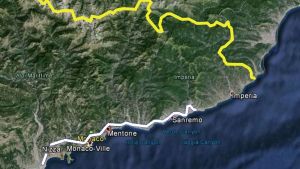 The works for the opening of the new road of the Cornice, which began in 1810 and ended in 1826, brought considerable benefits to the city, which from that moment on could also count on land traffic (until then the movement of goods and passengers was exclusively by sea).
The works for the opening of the new road of the Cornice, which began in 1810 and ended in 1826, brought considerable benefits to the city, which from that moment on could also count on land traffic (until then the movement of goods and passengers was exclusively by sea).
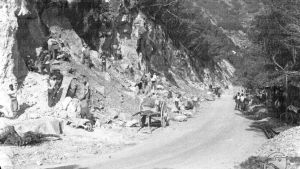 The road followed the coastline and also entered the valleys with secondary sections to connect the nearest towns: in our area, from Cape Nero it descended into the town at the Porta dei Cappuccini, then crossed the town centre following the Roman Via Julia Augusta, reached San Martino, and finally
The road followed the coastline and also entered the valleys with secondary sections to connect the nearest towns: in our area, from Cape Nero it descended into the town at the Porta dei Cappuccini, then crossed the town centre following the Roman Via Julia Augusta, reached San Martino, and finally 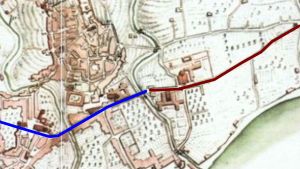 headed for Cape Verde.
headed for Cape Verde.
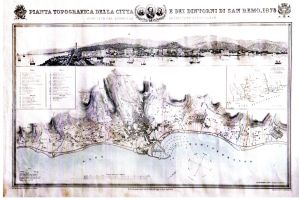 In the second half of the 19th century, the rise of tourism led to the gradual and orderly growth of the modern town, between the Pigna hill and the sea.
In the second half of the 19th century, the rise of tourism led to the gradual and orderly growth of the modern town, between the Pigna hill and the sea.
The first town plan, drawn up by engineer Innocenzo Bonfante, dates back to 1858. Others followed in the years 1873-75, 1880 and 1904, in step with the city's renewed urban needs.
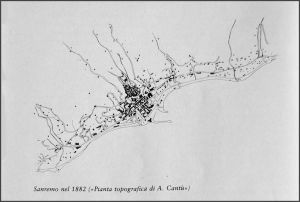 The mayors of the time worked in an exemplary manner for the development of a locality favoured by nature, which was identifying its future in a different socio-economic perspective from the traditional agricultural and maritime activities.
The mayors of the time worked in an exemplary manner for the development of a locality favoured by nature, which was identifying its future in a different socio-economic perspective from the traditional agricultural and maritime activities.
Siro Andrea Carli, (1828-1850) assisted by the intendant Alberto Nota, was the initiator of this development process when tourism was still unheard of. He provided the town with essential services: in 1828-30 he built the aqueduct, then moved the cemetery, opened the first sea promenades and the first stretch of the 'Strada Nuova' in 1843, the future Via Vittorio Emanuele II (today Corso Matteotti), the main thoroughfare of the town.
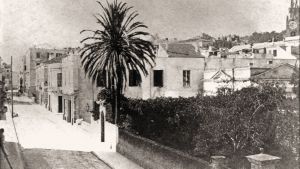 Stefano Roverizio di Roccasterone, during the years in which he was mayor (1844-48, 1850-55, 1873-75), devoted his main energies to the construction of new roads (1846, completion of the 'Strada Nuova' (formerly 'via Traversa' and since then via Vittorio Emanuele II and today Matteotti); 1851, Via Gioberti, opened to allow the transport of materials for the extension of the port, which was enlarged several times between 1853 and 1914).
Stefano Roverizio di Roccasterone, during the years in which he was mayor (1844-48, 1850-55, 1873-75), devoted his main energies to the construction of new roads (1846, completion of the 'Strada Nuova' (formerly 'via Traversa' and since then via Vittorio Emanuele II and today Matteotti); 1851, Via Gioberti, opened to allow the transport of materials for the extension of the port, which was enlarged several times between 1853 and 1914).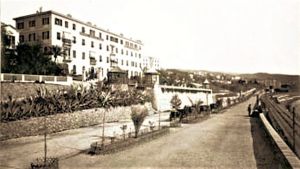 Antonio Bottini succeeded him between 1856 and 1872. During this period, Via Roccasterone, Via Feraldi, Via Carli, the Promenade Imperatrice (1869-71) and Via del Castillo were opened; the city's first major hotel, the Hotel des Londres, was built in 1860; the Grand Hotel Royal was inaugurated in 1871.
Antonio Bottini succeeded him between 1856 and 1872. During this period, Via Roccasterone, Via Feraldi, Via Carli, the Promenade Imperatrice (1869-71) and Via del Castillo were opened; the city's first major hotel, the Hotel des Londres, was built in 1860; the Grand Hotel Royal was inaugurated in 1871.
But the most important event of the century for the future development of San Remo was the arrival of the Genoa-Ventimiglia railway, inaugurated on 25 January 1872.
The titled tourists of the time, who appreciated the simple and pleasant character of the town, finally had a fast and comfortable means of transport.
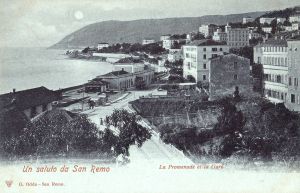 From that moment on, although the railway line had cut in half the narrow strip of land between the historic medieval quarters (which were excluded from the city's renewal process and lost their role forever), the newly created modern city streets and the sea, life was powerfully attracted to the tracks.
From that moment on, although the railway line had cut in half the narrow strip of land between the historic medieval quarters (which were excluded from the city's renewal process and lost their role forever), the newly created modern city streets and the sea, life was powerfully attracted to the tracks.
In the meantime, the city expanded from the new centre to the sides, westwards and eastwards, causing, among other things, a sharp rise in land prices and relegating agricultural activities to the hills, which were also being populated with villas.
There was also a change in the way of enjoying the landscape, which now favoured the areas from the railway line to the sea, to the detriment of a thoughtful reading of the historic centre of La Pigna, which began to be seen above all in terms of its 'picturesque' aspect.
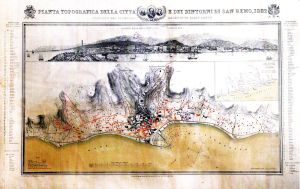 After the arrival of the railway, the transformation of San Remo can be said to have entered its decisive phase, with a clear distinction between the old and the new.
After the arrival of the railway, the transformation of San Remo can be said to have entered its decisive phase, with a clear distinction between the old and the new.
In fact, a guidebook from 1878 began its description of the town as follows: « San Remo is divided into the lower town and the upper town, which also means the new town and the old town ». Together with the city, its social and economic fabric was transformed, controlled by a group of entrepreneurs and professionals who had foreseen a fortunate future in tourism, from which they obtained prestige and wealth, at the same time favouring the raising of the standard of living of the entire population, which by 1881 had increased to 16,800 inhabitants.
Bartolomeo Asquasciati was mayor from 1878 to 1891. He had the good fortune to work in the golden age of San Remo's success as a health and holiday resort, a destination for aristocratic and bourgeois European tourists, apparently very reserved, who preferred the discreet tranquillity of the provincial town to the pomp and glamour of the major centres of the nearby Côte d'Azur.
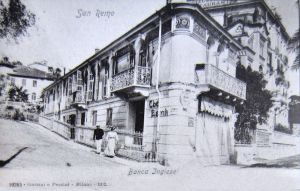 Asquasciati staked everything on tourism, and he was right. He favoured the activities of the entrepreneurs Bogge and Marsaglia, financing them through the bank that he owned with his brothers, the "English Bank". He contributed in a decisive way to create the first prestigious symbolic image of Sanremo tourism, made of nature, but also of pleased prestige lived in luxurious stays in big hotels or in villas, surrounded by parks with luxuriant tropical vegetation, acclimatised to the warm sun of the Riviera.
Asquasciati staked everything on tourism, and he was right. He favoured the activities of the entrepreneurs Bogge and Marsaglia, financing them through the bank that he owned with his brothers, the "English Bank". He contributed in a decisive way to create the first prestigious symbolic image of Sanremo tourism, made of nature, but also of pleased prestige lived in luxurious stays in big hotels or in villas, surrounded by parks with luxuriant tropical vegetation, acclimatised to the warm sun of the Riviera.
Together with the entrepreneurs of those years, he was able to give precise and adequate answers to the aspirations of the rich bourgeoisie that frequented the city.
In the last thirty years of the 19th century, twenty new hotels and at least two hundred villas were inaugurated in San Remo for the owners' stay or private residence.
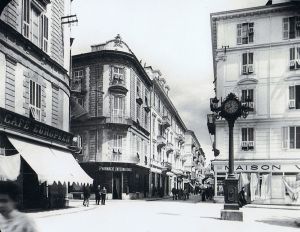 But Asquasciati also gave San Remo its own urban physiognomy, which can still be found today in the streets and houses of its modern centre, between Corso Imperatrice and Corso Garibaldi and the sea.
But Asquasciati also gave San Remo its own urban physiognomy, which can still be found today in the streets and houses of its modern centre, between Corso Imperatrice and Corso Garibaldi and the sea.
![]() The 1879 building regulations stipulated that new buildings in the centre had to have at least three floors and no more than four, in addition to the ground floor. The ground floor had to be 5 metres high, the other floors 4 metres high. The maximum height of the houses could not exceed 21 metres. Isolated buildings and small villas were permitted, provided they were elegantly decorated and surrounded by a garden.
The 1879 building regulations stipulated that new buildings in the centre had to have at least three floors and no more than four, in addition to the ground floor. The ground floor had to be 5 metres high, the other floors 4 metres high. The maximum height of the houses could not exceed 21 metres. Isolated buildings and small villas were permitted, provided they were elegantly decorated and surrounded by a garden.
Corners of houses that were not perfectly square had to be rounded off.
Even the external decorations followed a sufficient uniformity, adhering to the artistic trends of the time, which can be found today in the Art Nouveau friezes of the main buildings in the streets of the centre.
San Remo was thus acquiring its own character as an international tourist town, which nevertheless fulfilled its role as an elegant, discreet and refined « health and holiday resort », but also as a joyful leisure resort of European standing.
A few years' setback in this natural evolution occurred immediately after the disastrous earthquake that struck the far western part of Liguria on 23 February 1887.
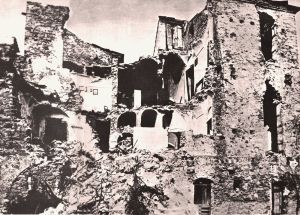 The consequences were dramatic at Bussana, which had 55 dead and dozens injured (it was even abandoned to be rebuilt at Capo Marine, near the sea), at Baiardo with 220 dead and 60 injured, at Diano Marina and in the neighbouring villages.
The consequences were dramatic at Bussana, which had 55 dead and dozens injured (it was even abandoned to be rebuilt at Capo Marine, near the sea), at Baiardo with 220 dead and 60 injured, at Diano Marina and in the neighbouring villages.
Everywhere the material damage was very serious, and even in San Remo there were numerous collapses, fortunately only with a few injuries, but no victims.
Of the terrible moments of the first quake there remains the testimony of Duke Gio Batta Borea d'Olmo, collected by Giuseppe Ferrari:
« It was dawn on Ash Wednesday... it was cold and an icy wind shook the window panes. When a distant roar reverberated from the sea and a violent suction threw open, shattering it cleanly, a window... I made a move to get up and go and close it, but in that instant I watched in amazement as my brother Agostino went up and down as if he were on a swing. All around us the glass rattled, then there was a dull thud and the statue of the Sacred Heart crashed to the floor... It seemed as if there was a vacuum around us, because the air was unbreathable because of the dust that had risen from the floor covered with rubble, it seemed to come out of a furnace, so much burning was in our throats and our eyes were full of tears... In the meantime, we could hear high-pitched cries of horror coming from the street, and crashes and collapses could be heard, while a reddish-coloured, dense, coruscating dust, under the sun... was merging with a thick fog that came down from the mountains in consecutive gusts and a smell of sulphur hung over everything, cutting off the breath. Three of the most disastrous tremors followed one another. At 6.25am, 6.32am and 8.55am... the first tremor lasted 35 seconds... ».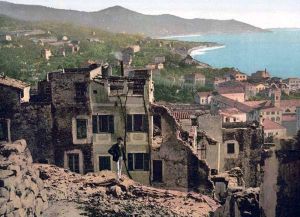 The greatest damage occurred in the upper part of the Pigna district and several half-destroyed houses were demolished. The sea district of Pian di Nave was shaken by gigantic waves 'never seen in living memory'.
The greatest damage occurred in the upper part of the Pigna district and several half-destroyed houses were demolished. The sea district of Pian di Nave was shaken by gigantic waves 'never seen in living memory'.
Another interesting testimony comes from M.C. Astraldi:
« An earthquake tremor, more formidable than any frightful imagination ... was felt by us so violently, that everyone expected at any moment to see San Remo converted into a huge pile of ruins. A rush of terrible elements, which would make the bravest men shudder from head to foot, set everything in motion, causing dancing furniture to crash against the walls, doors and windows to slam with a hideous crash, walls to creak ominously, and the faces of houses to creak: and meanwhile mirrors, pictures, chandeliers, crockery, towers of plates, were heard to fall to the ground with a deafening roar and to shatter; the agonising cries of the tenants were heard, who feared that they would be crushed at every moment by the ruin of the buildings rumbling with roars, crashes, desperate cries and prayers; and finally, after twenty seconds of terrible anguish, the earthquake began to lose its fury and came to an end. .. San Remo was the town that suffered the least damage, apart from a few cracks in the walls and vaults of the very few dwellings that made up the group of old houses to the north of the town; some of which, already worn down for years, were ruined and, fortunately, no human casualties were reported... The strangers staying in the hotels were greatly frightened: men and women rushed out of their flats, down the stairs in a hurry, and many young ladies in shirts could be seen on the public street and in the gardens... ».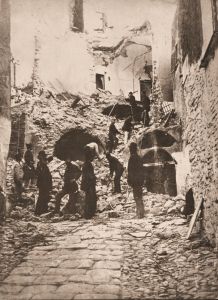 The relief and help, immediately organised, came from the San Remo Charity Society; the acts of courage and self-sacrifice were innumerable. Shortly afterwards, the Committee for the Relief of the Damaged, chaired by the Honourable Giuseppe Biancheri, collected substantial funds that were distributed to the unfortunate populations of the Porto Maurizio province.
The relief and help, immediately organised, came from the San Remo Charity Society; the acts of courage and self-sacrifice were innumerable. Shortly afterwards, the Committee for the Relief of the Damaged, chaired by the Honourable Giuseppe Biancheri, collected substantial funds that were distributed to the unfortunate populations of the Porto Maurizio province.
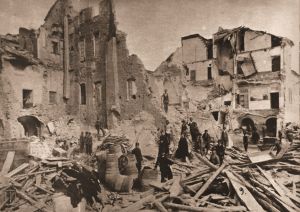 The intervention of the soldiers of the Corps of Engineers, called in to demolish the crumbling parts, was unfortunately the occasion for a hasty and unfortunate decision by the municipal administration to demolish precious historical evidence, which could and should have been saved. The entire area below the castle area, including the buildings facing the alleys Casevecchie and Caveire and Via Porte Santa Maria, the oldest in the city, was razed to the ground.
The intervention of the soldiers of the Corps of Engineers, called in to demolish the crumbling parts, was unfortunately the occasion for a hasty and unfortunate decision by the municipal administration to demolish precious historical evidence, which could and should have been saved. The entire area below the castle area, including the buildings facing the alleys Casevecchie and Caveire and Via Porte Santa Maria, the oldest in the city, was razed to the ground.
The square tower mentioned as 'turris in summitate' in a document of 1217, the courthouse built in 1273 by Federico da Vezzano, the old archiepiscopal palace, the old church of San Pietro (later dedicated to San Costanzo), the Candelieri and Santa Maria gates, as well as what remained of the castle, also fell into the ruins. The Regina Elena gardens were created on the vast area thus cleared.
The 20th century, among the many novelties, also brought the new socialist ideology, which in San Remo had in the banker and mayor Augusto Mombello and in the illustrious orator and criminal lawyer, later mayor himself, Orazio Raimondo, its main exponents.
In 1891 San Remo had a stable population of about 18,000 inhabitants. In the meantime, the city was equipping itself with avant-garde accommodation and tourist infrastructures 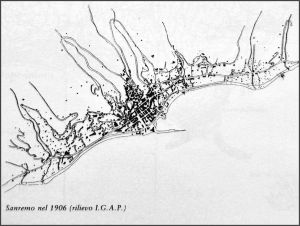 and during the winter it was hosting 20 to 25,000 foreigners thanks to tourism, which had become the primary economic activity.
and during the winter it was hosting 20 to 25,000 foreigners thanks to tourism, which had become the primary economic activity.
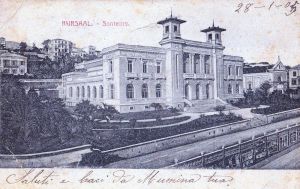 The hotels had multiplied considerably; the Casino was inaugurated in 1905 during the administration of Augusto Mombello and became the favourite winter holiday destination of the most select European aristocracy, nobles and sovereigns.
The hotels had multiplied considerably; the Casino was inaugurated in 1905 during the administration of Augusto Mombello and became the favourite winter holiday destination of the most select European aristocracy, nobles and sovereigns.
The stays of Tsarina Maria Alexandrovna (1874), the Grand Dukes of Russia (1875) and the Imperial Prince of Prussia Frederick William (1888) contributed greatly to its fame.
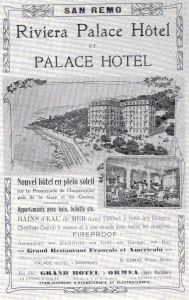
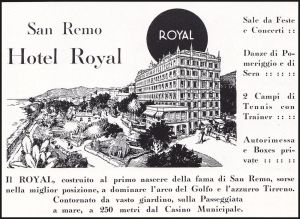 Illustrious personalities chose it as their favourite residence, and sumptuous villas on the hills surrounded by lush parks added to the Riviera's reputation as a prestigious health resort and garden, an image that continued to prevail until the outbreak of the First World War.
Illustrious personalities chose it as their favourite residence, and sumptuous villas on the hills surrounded by lush parks added to the Riviera's reputation as a prestigious health resort and garden, an image that continued to prevail until the outbreak of the First World War.
The town also made its own contribution in terms of men and sacrifices to the conflict and had many casualties. Moreover, as some hotels were requisitioned and turned into hospitals, there was a significant drop in tourism, which risked compromising the future of San Remo, which had been built up over the previous decades.
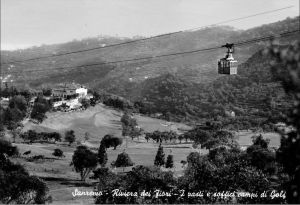 Under the administration of Mayor Ernesto Balestrieri (1899-1901 and 1915-1919), several roads were completed that reached, among other things, the new golf courses and the area where the equestrian field was to be built. Thanks to the proceeds from the Casino, which had quickly become a new symbol of the joie de vivre and personal escapism typical of the Belle époque and the subsequent 'Roaring Twenties', the city was able to count on secure funds to improve infrastructures and offer attractions to guests.
Under the administration of Mayor Ernesto Balestrieri (1899-1901 and 1915-1919), several roads were completed that reached, among other things, the new golf courses and the area where the equestrian field was to be built. Thanks to the proceeds from the Casino, which had quickly become a new symbol of the joie de vivre and personal escapism typical of the Belle époque and the subsequent 'Roaring Twenties', the city was able to count on secure funds to improve infrastructures and offer attractions to guests.
A considerable boost was given to public works in the town in the period between the two world wars, under the administrations of mayors (then called podestà) who were very attentive to the needs of the role of San Remo.
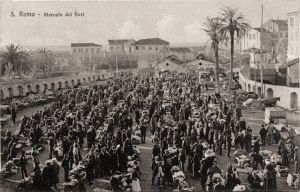 Under the podestà Carlo Bensa (1921-1924), the first Flower Market and the carriageway to San Romolo were inaugurated. At the same time, the city obtained the special law on the gambling house.
Under the podestà Carlo Bensa (1921-1924), the first Flower Market and the carriageway to San Romolo were inaugurated. At the same time, the city obtained the special law on the gambling house.
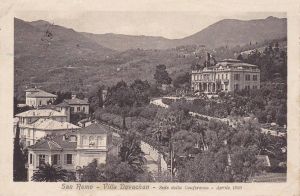 Between 19th and 26th April 1920, the second series of the Peace Conference was convened in San Remo, with the participation of the English, American, French, Japanese, Belgian, Yugoslavian and Italian delegations, housed in the city's main hotels.
Between 19th and 26th April 1920, the second series of the Peace Conference was convened in San Remo, with the participation of the English, American, French, Japanese, Belgian, Yugoslavian and Italian delegations, housed in the city's main hotels.
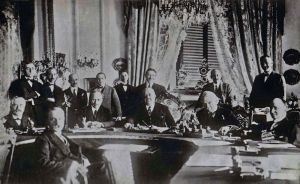 The seat of the Conference was the sumptuous Devachan castle, on the Berigo hill, to the furnishing of which had contributed furniture and works of art seized for insolvency from Gabriele D'Annunzio and purchased by the first owner, the English Earl of Mexborough.
The seat of the Conference was the sumptuous Devachan castle, on the Berigo hill, to the furnishing of which had contributed furniture and works of art seized for insolvency from Gabriele D'Annunzio and purchased by the first owner, the English Earl of Mexborough.
The issues discussed at the San Remo Peace Conference concerned the internationalisation of the straits of Turkish territory, the assignment to France of 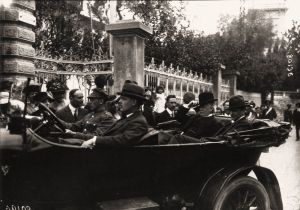 the mandate over Syria and Lebanon, and to Great Britain the mandate over Palestine and Mesopotamia, in the context of the Jewish question; the problem of oil was resolved and the question of German disarmament was hotly debated, with the main decisions being postponed until the future conference in Spa.
the mandate over Syria and Lebanon, and to Great Britain the mandate over Palestine and Mesopotamia, in the context of the Jewish question; the problem of oil was resolved and the question of German disarmament was hotly debated, with the main decisions being postponed until the future conference in Spa.
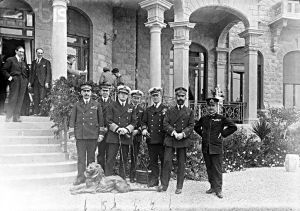 Even the Adriatic question, which particularly interested Italy, was postponed to a direct negotiation; the agreement was signed the following November in Rapallo. The final balance that observers drew from the San Remo conference was that of a 'mutilated victory' for Italy, with very unsatisfactory results for our country.
Even the Adriatic question, which particularly interested Italy, was postponed to a direct negotiation; the agreement was signed the following November in Rapallo. The final balance that observers drew from the San Remo conference was that of a 'mutilated victory' for Italy, with very unsatisfactory results for our country.
However, the Conference was of considerable importance for the relaunch of tourism in San Remo. At its conclusion, the Prime Minister Francesco Nitti sent the following telegram to the Royal Commissioner:
At its conclusion, the Prime Minister Francesco Nitti sent the following telegram to the Royal Commissioner:
« Please convey to this citizenship my appreciation for the friendly and courteous welcome. The work of the Conference was able to take place peacefully in an environment that could not have been more suitable or more beautiful. I am very happy to have chosen San Remo as the seat of the Peace Conference. Nitti ». (L. Pippione, La Conferenza di Pace a San Remo, in " Civitas Sancti Romuli ", San Remo 1986, pp. 24-32).
We would like to recall here that, during the Fascist regime, all the functions of the mayor, the council and the municipal council were annulled and united in the figure of the Podestà appointed by the government by royal decree. He remained in office for 5 years and could only be removed by the Prefect or reconfirmed by the same.
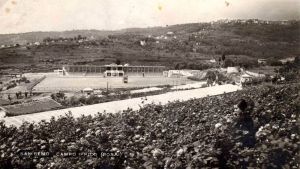 The first Podestà of Sanremo was Pietro Agosti (1925- 1930) who, thanks to the new powers given to him by his new position, did a great deal to improve the appearance of the town. He opened other streets, bought the Villa Ormond with its 50,000 square metres of luxuriant gardens, started the construction of the Solaro Riding Course and the shooting range.
The first Podestà of Sanremo was Pietro Agosti (1925- 1930) who, thanks to the new powers given to him by his new position, did a great deal to improve the appearance of the town. He opened other streets, bought the Villa Ormond with its 50,000 square metres of luxuriant gardens, started the construction of the Solaro Riding Course and the shooting range.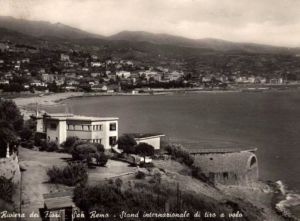
Being a talented architect, he also contributed to the building renovation of San Remo, realising the Russian Church and several buildings, hotels and villas in a very personal style. Despite his fruitful work Pietro Agosti committed suicide in 1930, embittered by slanders that had affected his private life.
The economic and tourist recovery of the city in the period between the two world wars was also favoured by the achievements of some mayors, among whom we will remember Carlo Bensa (1921-1924), Pietro Agosti (1925-1930) and Giovanni Guidi (1933-1939).
San Remo was transforming from a large town into a modern city. When it had reached a level of evolution that allowed it to compete with the nearby tourist resorts of the Côte d'Azur and to prevail, the Second World War broke out. 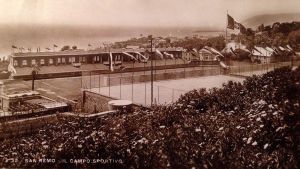
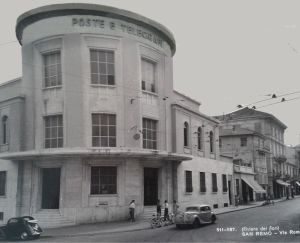 Under the administration of Giovanni Guidi, the works begun by Agosti were completed, such as the completion and arrangement of the Solaro horse-riding course, the widening of Corso Imperatrice, the inauguration of the Golf Club and the Littorio sports ground, then the construction of the new Post Office building and the covering of the San Romolo stream in the section between Via Roma and Corso Carlo Alberto.
Under the administration of Giovanni Guidi, the works begun by Agosti were completed, such as the completion and arrangement of the Solaro horse-riding course, the widening of Corso Imperatrice, the inauguration of the Golf Club and the Littorio sports ground, then the construction of the new Post Office building and the covering of the San Romolo stream in the section between Via Roma and Corso Carlo Alberto.
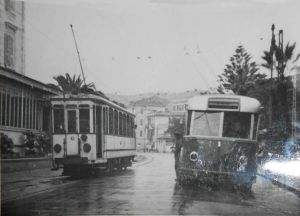 Guidi provided the city with a modern trolleybus service, inaugurated the prestigious 'Lunedì letterari' (Literary Mondays) and concerts at the Casino, and advocated moving the railway upstream.
Guidi provided the city with a modern trolleybus service, inaugurated the prestigious 'Lunedì letterari' (Literary Mondays) and concerts at the Casino, and advocated moving the railway upstream.
Several events took place during 1934.
On 25 March, elections were held for the renewal of the Chamber of Deputies. As was widely expected, the government list obtained almost all the votes. The same results were obtained in the province of Imperia, where Giovanni Guidi, the mayor, and Ernesto Parodi, a member of the Sanremo Fascio, were among those elected.
On 14th April, the general meeting of the Società Anonima Casinò Municipale decided to change its name to the Società Anonima Iniziative Turistiche (SAIT).
After the death of its Concessionaire, Luigi De Santis, on 31 October 1934, his widow, Maria Strambini, sold the entire stock of the SAIT to Cavalier Angelo Belloni. 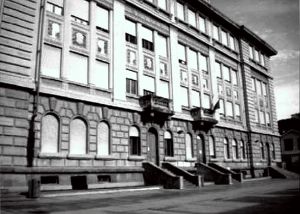 Also in 1934, the grandiose primary schools building in Via Volta was inaugurated, capable of accommodating 1600 pupils.
Also in 1934, the grandiose primary schools building in Via Volta was inaugurated, capable of accommodating 1600 pupils.
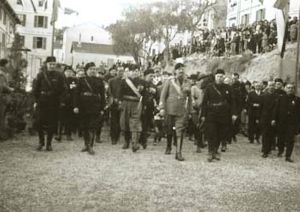 On 28 October 1936, in the presence of the undersecretary for communications Giovanni Host Venturi, the Sanremo-Monte Bignone cable car was
On 28 October 1936, in the presence of the undersecretary for communications Giovanni Host Venturi, the Sanremo-Monte Bignone cable car was 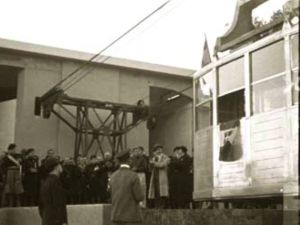 inaugurated, which remained the longest in the world for decades.
inaugurated, which remained the longest in the world for decades.
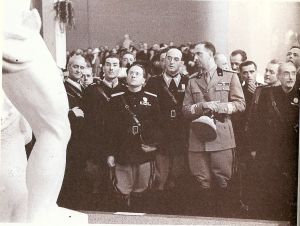
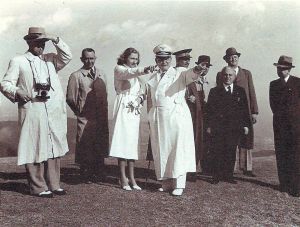 In 1938 the general secretary of the National Fascist Party Achille Starace visited Sanremo, while the following year Field Marshal Hermann Göring came.
In 1938 the general secretary of the National Fascist Party Achille Starace visited Sanremo, while the following year Field Marshal Hermann Göring came.
In December 1939, Podestà Guidi resigned to leave as a volunteer for Albania, and was replaced by the prefectural commissioner Camillo Bruno.
At the beginning of January 1940, the Ministry of War decided to transfer the 42nd Infantry Regiment, which had been stationed in Sanremo since 1920, to Genoa and replace it with the 90th, which arrived in the Matuzian city directly from Turin. Also in January 1940 the new mayor Silvio Silvestri took office, who would remain in office until September 1943.
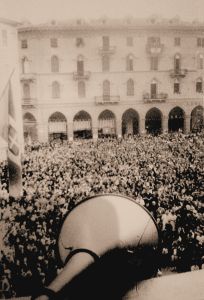 On 10 June 1940, in a crowded Piazza Colombo, the people of Sanremo heard Mussolini's speech officially announcing Italy's entry into the war against France and Great Britain.
On 10 June 1940, in a crowded Piazza Colombo, the people of Sanremo heard Mussolini's speech officially announcing Italy's entry into the war against France and Great Britain.
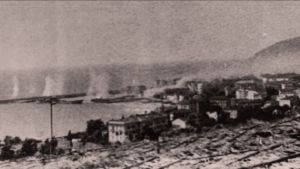 At 10.30 a.m. on 13 June, the first wartime alarm sounded. At 10.55 p.m., the first aerial bombardment took place, resulting in one fatality.
At 10.30 a.m. on 13 June, the first wartime alarm sounded. At 10.55 p.m., the first aerial bombardment took place, resulting in one fatality.
In the following days, the short campaign against France took place, with fighting in the border area of Ventimiglia.
On the 24th of June the armistice of Villa Incisa was signed, putting an end to hostilities, while the next day the Italian troops proceeded to occupy Menton.
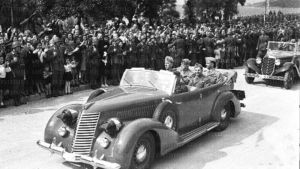 On the 26th of June Vittorio Emanuele III arrived in Sanremo and settled in the Villa del Sole, guest of the minister of the Royal House Pietro Acquarone.
On the 26th of June Vittorio Emanuele III arrived in Sanremo and settled in the Villa del Sole, guest of the minister of the Royal House Pietro Acquarone.
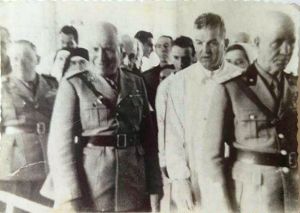 On 1 July, Mussolini also arrived in San Remo, visiting the Italian and French wounded in the civil hospital.
On 1 July, Mussolini also arrived in San Remo, visiting the Italian and French wounded in the civil hospital.
On 12th March 1943 Don Orione's Piccolo Cottolengo was inaugurated in the premises of the former convent of San Nicola.
The city was sorely tried by the war. On 13 June 1940 it suffered one of the first air raids since the war began, and it endured the last naval bombardment on 25 April 1945, while the population had already taken to the streets to welcome the liberating partisans.
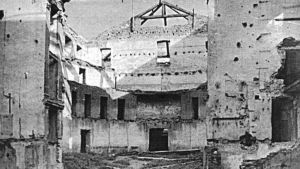 Between those two dates, the alarm siren sounded more than a thousand times and there were seventy bombardments, both air and naval.
Between those two dates, the alarm siren sounded more than a thousand times and there were seventy bombardments, both air and naval.
The beginning of that ordeal is recalled in the words of Giuseppe Ferrari:
« It is June 1940. The war between the Allied States and Italy had been declared, but no cannonades were yet heard. But from 10.30 a.m. on 13 June, the feast of St Anthony, the alarm signal echoed sinisterly. General confusion, a stampede. Curiosity, noses turned up in the air waiting for something to happen, but nothing bad. But at 10.35 p.m. on the same day, the lugubrious shriek of the sirens echoes and at the same time the first bombs fall on the city. The old man from Sanremo, Giuliano Gandolfo, was killed as he was about to close the window, hit in the chest by a piece of shrapnel... The next day France demanded the surrender and life in San Remo resumed as normal as it can be in wartime ».
The second bombing suffered by the city occurred three years later, on April 14, 1943, when an isolated aircraft launched some incendiary shells.
On 25 July of the same year, the Fascist regime fell and Sanremo too saw numerous demonstrations of popular jubilation at the end of the dictatorship.
After 8th September (day of the armistice) , the Riviera di Ponente was occupied by German troops. In September 1943 Mario Garaccioni was appointed prefectural commissioner, who governed the municipality until the following October, when he was succeeded by Alfonso Chiodo, who was replaced in May 1944 by commissioner De Rossi.
In the meantime, immediately after the announcement of the armistice, various groups of anti-fascists had resumed political activity in Sanremo in the open, forming an Action Committee made up of representatives of the Christian Democrats, the Italian Communist Party, the Italian Socialist Party of Proletarian Unity and later the Action Party, plus an independent.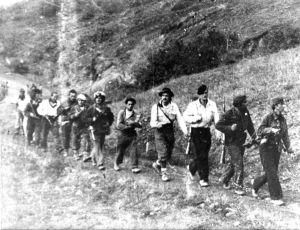 The disorganization of the various forces engaged in the fight against the Nazi-fascists, however, soon made emerge the need to achieve a real unity of action between the components of the anti-fascist town, which in May 1944 formed the first National Liberation Committee (CNL) of San Remo. However, the first Sanremo CNL was not able to carry out an effective political and military action.
The disorganization of the various forces engaged in the fight against the Nazi-fascists, however, soon made emerge the need to achieve a real unity of action between the components of the anti-fascist town, which in May 1944 formed the first National Liberation Committee (CNL) of San Remo. However, the first Sanremo CNL was not able to carry out an effective political and military action.

In July 1944 the Sanremo CLN promoted the constitution of the first nuclei of the town Patriotic Action Groups (GAP), which took the name of Gap Brigade "Giacomo Matteotti". Among the many actions carried out by the Gap in Sanremo against the Nazi-Fascists, we would like to mention the attack against the barracks in Via Privata (today's Via Escoffier); the assault against the Casa del Fascio, the coup against the German garrison in San Romolo and the elimination of eight German soldiers, seven Bersaglieri and over twenty-five Nazi-Fascist spies.
Towards the middle of July 1944, the PCI and the Psiup gave life to the first peripheral Sanremo CLN, that of San Martino, which assumed the functions of municipal CLN.
In September 1944 the first Patriotic Action Squads (SAP) were created in Sanremo and in other localities in the area, including Poggio, Bussana, Arma di Taggia and Coldirodi.
On 15 November 1944, the partisan Aldo Baggioli was killed during a round-up by the Germans in San Romolo.
On 16 October 1944, meanwhile, the Nazi-Fascists had carried out the most massive round-up of the entire period of German occupation of the town.
The most tragic year for the people of Sanremo was 1944. The bombardments followed one another, starting on 8 January, in a frightening sequence: 21 April, 28 July, 31 July, then eleven in August, ten in September, six in October, until the last one on 31 December 1944.
On 20 October of the same year, the most disastrous naval bombardment of the war took place.  The French destroyer 'Forbin' was escorting two minesweepers engaged in clearing the bay's sea area, according to a very normal operational plan, which
The French destroyer 'Forbin' was escorting two minesweepers engaged in clearing the bay's sea area, according to a very normal operational plan, which 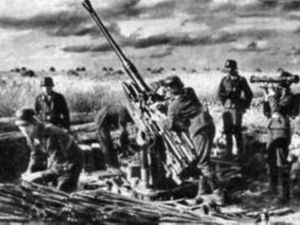 envisaged returning fire only in case of attack. But the German battery, positioned near the beach, opened fire on the French ships, despite having received orders not to fire first.
envisaged returning fire only in case of attack. But the German battery, positioned near the beach, opened fire on the French ships, despite having received orders not to fire first.
 The ships responded with their on-board guns with a first broadside towards the beach line, but the shot fell short.
The ships responded with their on-board guns with a first broadside towards the beach line, but the shot fell short.
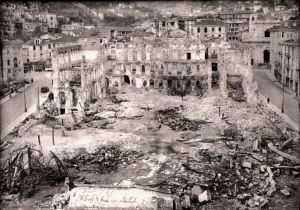 Following the second broadside at 11.54 a.m., having stretched the shot a little too far, the shells hit the Flower Market building in the centre of the city, which the Germans had secretly turned into a depot for Molch pocket submarines, Linsen lookouts and huge quantities of explosives and ammunition of all kinds.
Following the second broadside at 11.54 a.m., having stretched the shot a little too far, the shells hit the Flower Market building in the centre of the city, which the Germans had secretly turned into a depot for Molch pocket submarines, Linsen lookouts and huge quantities of explosives and ammunition of all kinds.
 The explosion that followed pulverised the entire building and the adjoining court building, damaging the Chiesa degli Angeli and all the surrounding houses for a radius of about a hundred metres, causing numerous victims and leaving many citizens homeless.
The explosion that followed pulverised the entire building and the adjoining court building, damaging the Chiesa degli Angeli and all the surrounding houses for a radius of about a hundred metres, causing numerous victims and leaving many citizens homeless.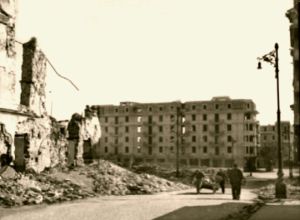 The year 1945 also brought San Remo an interminable series of bombings: five in January, sixteen in February, seven in March and six in April. No part of the town was spared, historic buildings, villas and humble houses all shared the same fate.
The year 1945 also brought San Remo an interminable series of bombings: five in January, sixteen in February, seven in March and six in April. No part of the town was spared, historic buildings, villas and humble houses all shared the same fate.
In the last days of April, the imminence of the end of the war was felt. On the 23rd, the Germans blew up ammunition depots before retreating, on the 24th, the last fugitives fired mortars at random, and on the 25th April 1945, the town was occupied by partisans.
But just as people were preparing to celebrate this memorable day, the siren sounded for the last time.
Among the partisans who came down from the mountains to San Remo was Italo Calvino, in 1945 aged 22. We leave to his magic pen the task of recalling those hours and thus conclude the synthesis of the history of San Remo:
« There had been a fire in a forest; I remember the long line of partisans going down among the burnt pines, the hot ashes under the soles of their shoes, the stumps still glowing in the night. It was a different march from the others in 1944, our life of continual nocturnal movement in those woods. We had finally been ordered to descend on our town, Sanremo; we knew the Germans were retreating from the Riviera; but we didn't know which strongholds were still in their hands. These were days when everything was moving and certainly our commands were informed by the hour; but here I try to keep to my memories of a simple Garibaldian who followed his detachment with a limp because of an abscess in one of his feet (since the frost had hardened and crumpled the leather of my boots, my feet had begun to hurt). That Germany was doomed this time seemed certain, but we had had many illusions in those years and had been disappointed too many times, so we preferred not to make any more predictions.
The front line closest to us - the one on the French border - showed no sign of moving. For eight months, that is to say since France had been liberated, we could hear the cannons roaring in the west; For eight months freedom had been just a few kilometres away, but in the meantime the life of the partisans in the Maritime Alps had become harder and harder because, as the rear of the front, our area was of vital importance to the Germans, who had to keep the roads clear at all costs; that's why they never gave us a break, nor us to them; and that's why our area had one of the highest casualty rates.
Even in those weeks when spring was in the air (it was, however, a very cold April) and the feeling of victory was imminent, there remained the uncertainty that had characterised our lives for so many months. Even in the last few days the Germans had come by surprise and we had had casualties. Just a few days before, I had almost fallen into their hands while on patrol.
The last camp of our unit, if I remember correctly, was between Montalto and Badalucco: the fact that we had gone down into the olive groves was already a sign of a new season, after the winter in the chestnut groves, which meant hunger. By now, we could no longer reason in any other way than in terms of what was bad or good for our survival as partisans, as if this life had to go on for who knows how long. The valleys were once again covered with leaves and bushes, which meant that we had a better chance of keeping under cover under enemy fire, as in that patch of hazelnut trees that had saved my brother and I's lives some twenty days earlier after an action on the Ceriana road.
The very idea that life was about to open up with no more volleys, no more round-ups, no more fear of being caught and tortured, was useless as long as our lives were hanging by a thread. And even after peace had come, getting our minds used to working in another way had to take its time.
I think we slept only a few hours that night, for the last time lying on the floor. I thought that the next day there would be a battle to take over the Via Aurelia, my thoughts were those of the eve of a fight, rather than those of imminent liberation. Only the next morning, seeing that our descent continued unabated, did we realise that the coast was already free and that we were marching directly on Sanremo (in fact, after a few rearguard battles with the town's Gappist formations, the Germans and Fascists had retreated towards Genoa).
But, still that morning, the Allied navy had appeared off the coast of Sanremo and had begun the daily naval bombardment of the town. The town's C.L.N. had taken power under the cannonade and as the first act of government had the 'liberated zone' written in huge letters in white paint on the walls of Corso Imperatrice so that it could be seen by the warships. Around Poggio we began to meet people on the side of the road who came to see the partisans go by and to party with us. I remember that the first thing I saw was two old men with hats on their heads, chatting about their business as if it were any other day, but there was one thing that would have been inconceivable until the day before: they had red carnations in their buttonholes. In the following days I was to see thousands of people with red carnations in their buttonholes, but those were the first.
I can safely say that for me that was the first image of freedom in civil life, freedom without the risk of life, which was presented so casually, as if it were the most natural thing in the world.
As we approached the town, the people, the rosettes, the flowers, the girls increased, but as I approached home, I was reminded of my parents who had been held hostage by the SS and I did not know whether they were alive or dead, just as they did not know whether their children were alive or dead.
I see that these memories of Liberation Day are directed more towards the 'before' than the 'after'. But this is how they have remained in our memory, because we were all caught up in what we had experienced, while the future did not yet have a face, and we would never have imagined a future that would have caused these memories to slowly fade as they have over the last thirty years ». (Italo Calvino, 25 April 1945-25 April 1985..., cit., pp. 7-8. The article was written to commemorate the thirtieth anniversary of the Resistance).
On 1 January 1945 the new Sanremo District CLN was launched. In January 1945 the Sanremo CLN had also promoted the publication of its own official organ, "La Voce della Democrazia", directed by Dr Luigi Ludovico Millo and co-directed by the young Italo Calvino.
At the Beusi conference on 9 February 1945, the Sanremo Cln was granted operational autonomy and jurisdiction over the area between Santo Stefano al Mare and Ventimiglia.
On March 5, 1945 the Nazi-Fascists shot sixteen partisans in the garden of Devachan Castle in reprisal.
In the meantime, the day of liberation was approaching also for Sanremo. After the breakthrough of the Gothic line by the allied troops, throughout the day of 24 April there was fighting in the town between partisans and Nazi-fascists, who were finally forced to surrender.
In the meantime, the CLN representatives had occupied the town hall, hoisting the tricolour and the red flag. Immediately afterwards the same Cln appointed Adolfo Siffredi of the Psiup as the first mayor of the city after the Liberation.
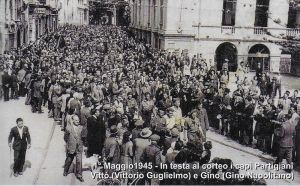
On 1 May, the partisans of the V Brigata d'Assalto Garibaldi "Luigi Nuvoloni" paraded through the streets of the city, receiving enthusiastic welcomes from the population.
(sources: free elaboration of texts taken from the books: "Sanremo Storia e Anima di una Città" by Enzo Bernardini; "Storia Tascabile di Sanremo" by Andrea Gandolfo; images from private archives)




